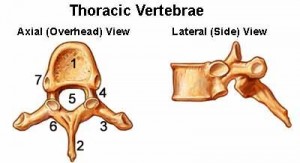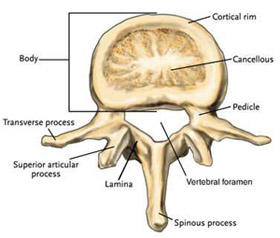The spinal column is made up of individual vertebrae that are stacked one on top of the other from the tailbone to the base of the skull. The functions of the spinal column include providing a passageway and protection for the spinal cord and the nerves that emanate from the spine to the rest of the body, as well as bearing the weight of the head and providing support for our vital organs.
There are three types of vertebrae that correspond to the different sections of the spine. The three sections are the lumbar, thoracic and cervical—they share similarities and are also wildly different. One similarity is that each vertebrae can be divided into a front and back half. The front half, the body, is responsible for weight bearing while the job of the back half is to regulate movement and provide attachment for ligaments and tendons.
The largest portion of each vertebrae is the body, responsible for bearing much the weight that is transferred from the head down through the spinal column into the pelvis and the legs. The back of the body of each vertebrae forms half of the spinal canal.
The front and back portion of each vertebrae are connected by two bones called pedicles that make up the sides of the spinal canal. The back half of the vertebrae is a series of bones that run from the outside to the center.
The Makeup of a Vertebrae
- Transverse process (not found in the cervical vertebrae) – are an attachment point for the tendons and ligaments of the back to attach to the spine.
- Facet joints- connect the vertebrae together through two sets of joints on either side of the spinous process. One set faces upward and one set faces downward. These are small stabilizing joints surrounded by synovial fluid which allow for the smooth movement of the spine.
- Lamina- between the facet joint and the spinous process they make up the back wall of the spinal canal.
- Spinous process- (not found in the cervical spine) are attachment points for tendons and ligaments and their shape can limit or make accessible movements in different parts of the spine.
The vertebrae are connected to each other by the fluid filled disks that reside between them and by the facet joints. The vertebrae are different shapes and sizes in different parts of the spine. They are largest in the lumbar spine for weight bearing purposes and get smaller as they go up. No matter the shift in shape and size all of the vertebrae provide space for the spinal cord which comes out of the brain and ends around the first or second lumbar vertebrae.




